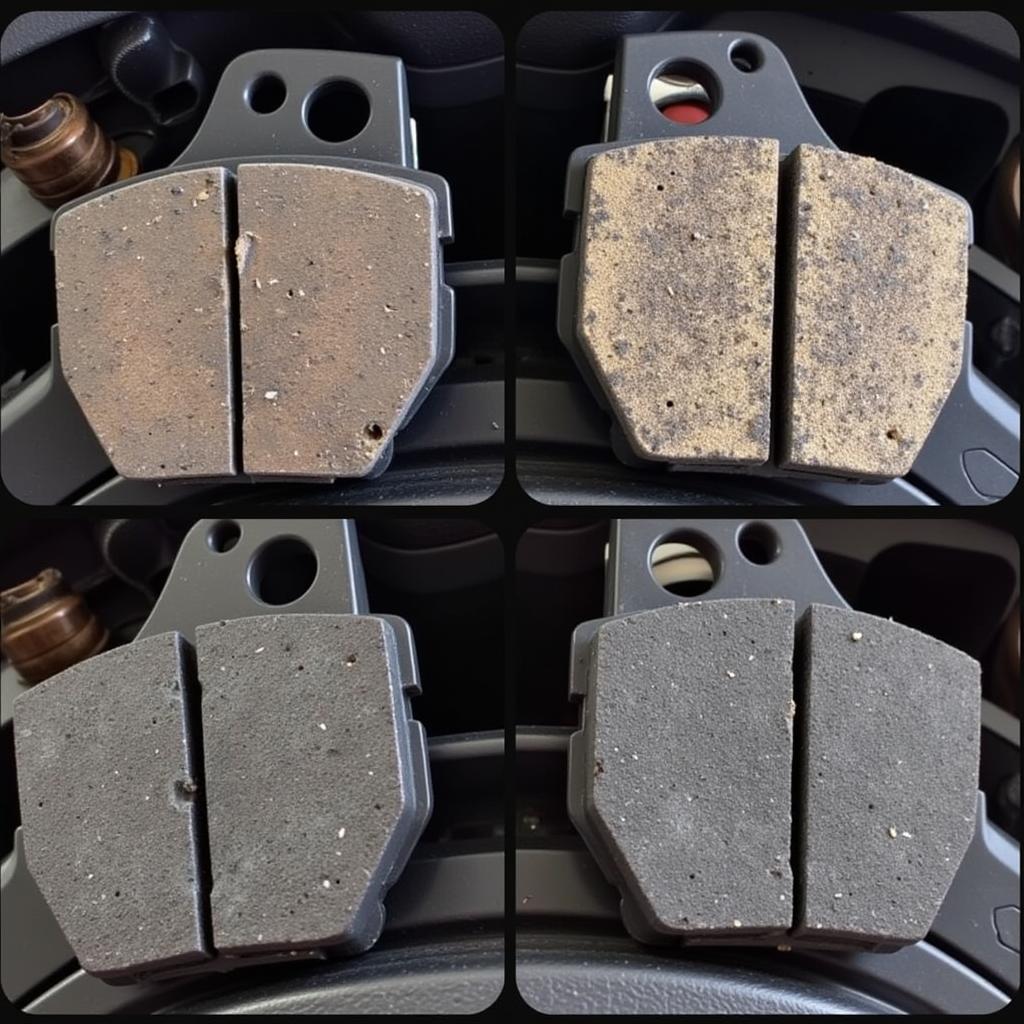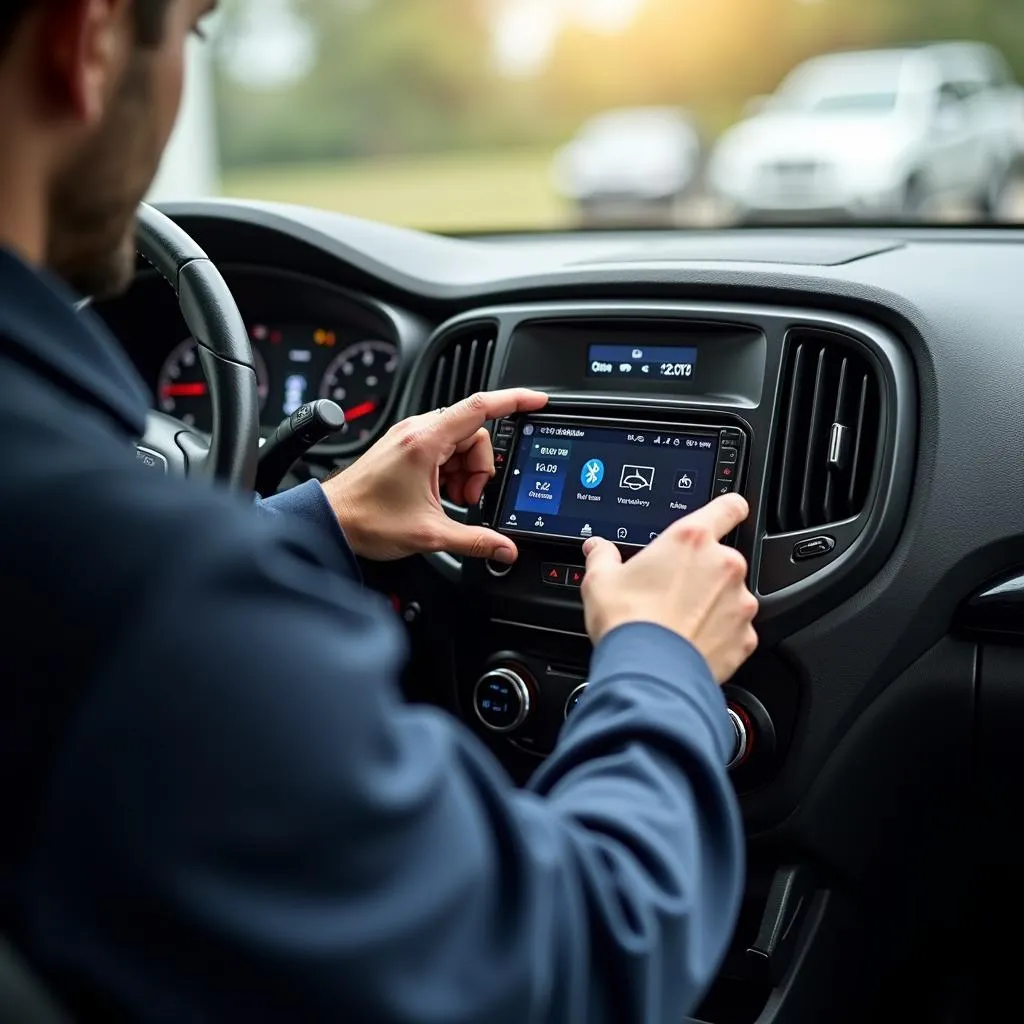The brake pad warning light illuminating on your Land Rover Discovery Sport’s dashboard is a clear signal that requires your immediate attention. This light is your vehicle’s way of communicating a potential issue with your braking system, specifically the condition of your brake pads. Ignoring this warning could compromise your safety and lead to more extensive damage.
This comprehensive guide will equip you with the knowledge to understand, diagnose, and address the brake pad warning light on your Land Rover Discovery Sport, ensuring a safe and enjoyable driving experience.
Deciphering the Brake Pad Warning Light
 Land Rover Discovery Sport Brake Pad Warning Light
Land Rover Discovery Sport Brake Pad Warning Light
The brake pad warning light, typically a circular symbol with an exclamation mark inside, is designed to activate when your brake pads wear down to a critical level. This usually occurs when the friction material on the pads, responsible for generating the stopping force, is significantly reduced, compromising their ability to effectively grip the brake rotors.
Common Causes of the Warning Light
While worn brake pads are the most common culprit, several other factors can trigger the brake pad warning light on your Land Rover Discovery Sport:
- Worn Brake Pad Sensor: Most modern vehicles, including the Discovery Sport, are equipped with brake pad wear sensors. These sensors, small wires embedded within the brake pad material, trigger the warning light when they come into contact with the brake rotor due to excessive pad wear.
- Faulty Brake Pad Sensor: Like any electrical component, brake pad sensors can malfunction. A damaged or broken sensor wire can send a false signal to the vehicle’s computer, illuminating the warning light even if the brake pads are in good condition.
- Low Brake Fluid Level: Brake fluid plays a crucial role in transmitting the force applied to the brake pedal to the brake calipers, effectively stopping your vehicle. If the brake fluid level is too low, it could indicate a leak in the system or worn brake pads, triggering the warning light.
- Issues with the Brake System: In rare cases, problems within the brake system itself, such as a faulty ABS module or a malfunctioning brake caliper, can trigger the warning light.
Diagnosing the Issue
Determining the root cause of the brake pad warning light requires a systematic approach:
- Inspect Your Brake Pads: If you feel comfortable doing so, visually inspect your brake pads by looking through the spaces between the wheel spokes. Look for significantly thin pads or a noticeable difference in thickness compared to new brake pads.
- Check Your Brake Fluid: Locate the brake fluid reservoir under the hood of your Discovery Sport. Ensure the fluid level is within the minimum and maximum markers on the reservoir.
- Consult a Qualified Technician: If you are unsure about your findings or suspect a more complex issue, it’s crucial to seek professional assistance. A qualified technician can accurately diagnose the problem using specialized equipment and recommend the appropriate course of action.
Addressing the Brake Pad Warning Light
The solution to the brake pad warning light will depend on the underlying cause:
- Worn Brake Pads: If your brake pads are worn, they will need to be replaced. It’s highly recommended to have a professional mechanic perform this task as it requires specialized tools and knowledge.
- Faulty Brake Pad Sensor: A malfunctioning sensor will need to be replaced. This is a relatively straightforward procedure for a qualified technician.
- Low Brake Fluid: If the brake fluid level is low, top it off to the appropriate level using the correct type of brake fluid specified in your owner’s manual. If the level continues to drop, it indicates a leak that needs immediate attention from a professional.
- Brake System Issues: Addressing problems within the brake system itself requires the expertise of a qualified technician. They can diagnose the specific issue and perform the necessary repairs.
The Importance of Timely Action
Ignoring the brake pad warning light can lead to serious consequences:
- Reduced Braking Performance: Worn brake pads significantly reduce your vehicle’s ability to stop effectively, increasing the risk of accidents.
- Damage to Brake Rotors: Driving with worn brake pads can cause damage to the brake rotors, leading to costly repairs.
- Complete Brake Failure: In extreme cases, ignoring the warning light can lead to complete brake failure, putting you and others at serious risk.
 Worn Brake Pads on Land Rover Discovery Sport
Worn Brake Pads on Land Rover Discovery Sport
“Ignoring the brake pad warning light is like driving with your eyes closed,” warns John Smith, a seasoned automotive technician with over 20 years of experience working on Land Rover vehicles. “It’s simply not worth risking your safety or incurring expensive repairs.”
Preventing Future Issues
Adopting proactive measures can help prevent brake pad warning light issues in the future:
- Regular Brake Inspections: Schedule routine brake inspections, at least once a year or as recommended by your vehicle’s manufacturer.
- Mindful Driving Habits: Avoid aggressive driving habits like hard braking and sudden acceleration, which can accelerate brake pad wear.
- Quality Brake Pads: When replacing your brake pads, opt for high-quality pads from reputable manufacturers to ensure optimal performance and longevity.
Conclusion
The brake pad warning light on your Land Rover Discovery Sport is a critical safety feature that should never be ignored. Understanding its significance and taking prompt action can help you avoid potentially dangerous situations and costly repairs. Remember, maintaining a healthy braking system is paramount to your safety and the safety of others on the road.
Frequently Asked Questions:
- How long can I drive with the brake pad warning light on?
It’s not advisable to drive with the brake pad warning light illuminated. It’s crucial to have your brakes inspected and addressed immediately to ensure safe driving conditions.
- Can I replace my own brake pads on my Land Rover Discovery Sport?
While it’s technically possible, replacing brake pads is a complex procedure that requires specialized tools and knowledge. It’s highly recommended to have a qualified technician perform this task for optimal safety and performance.
- How often should I replace my brake pads?
Brake pad lifespan varies depending on driving conditions and habits. However, it’s generally recommended to have them inspected at least once a year or as recommended by your vehicle’s manufacturer.
- What type of brake pads are best for my Land Rover Discovery Sport?
Consult your owner’s manual or a Land Rover dealership to determine the recommended type of brake pads for your specific vehicle model and year.
- Can driving in heavy traffic cause my brake pads to wear faster?
Yes, frequent braking and stop-and-go traffic conditions can accelerate brake pad wear.

